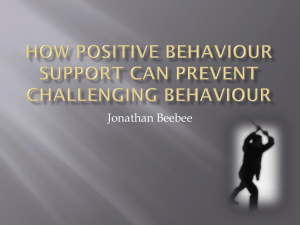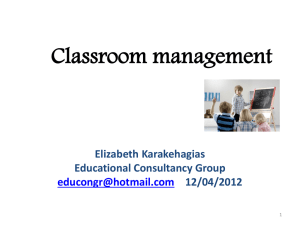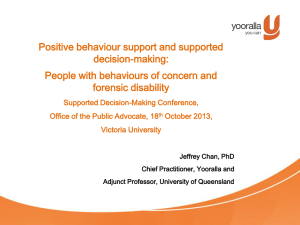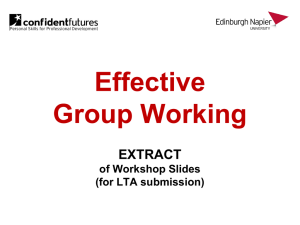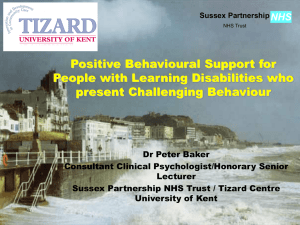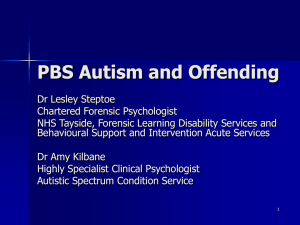Amy Kilbane - Forensic Network
advertisement
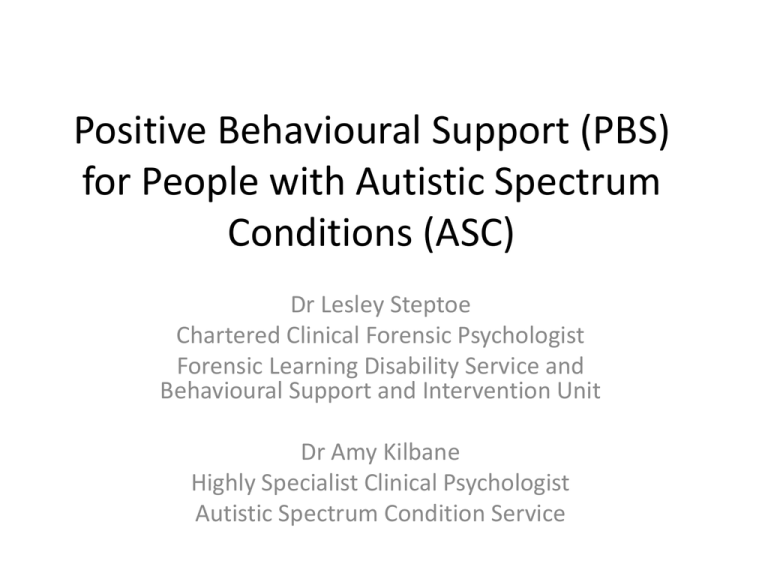
Positive Behavioural Support (PBS) for People with Autistic Spectrum Conditions (ASC) Dr Lesley Steptoe Chartered Clinical Forensic Psychologist Forensic Learning Disability Service and Behavioural Support and Intervention Unit Dr Amy Kilbane Highly Specialist Clinical Psychologist Autistic Spectrum Condition Service Aims • To provide an overview of the PBS model. • To provide an overview of where PBS fits with current policy direction and evidence base for individuals with ASC. • To illustrate the use of the PBS approach with an individual with ASC and offending needs. Positive Behavioural Support (PBS) • Person centred approach which conceptualises challenging behaviour (CB) as having a function and a meaning to an individual. • Seeks to understand that function and meaning from the perspective of the individual using functional analysis. • Values based system of interventions which uses behavioural strategies to promote personal competence, respect and community participation, rather than simply achieving behavioural change. • Proactive and constructive approach, with a combination of preventative and planned reactive strategies. • Quality of life as an intervention and an outcome. PBS- A Multielement Model (La Vigna & Willis, 1995) Process Assessment Content Materials PROACTIVE STRATEGIES ECOLOGICAL CHANGES POSITIVE PROGRAMMING REACTIVE FOCUSED SUPPORT SITUATIONAL MANAGEMENT SERVICE DESIGN TRAINING SOCIAL CHANGE AGENTS OUTCOMES SPEED & DEGREE OF EFFECTS DURABILITY OF EFFECTS GENERALISATION OF EFFECTS SIDE EFFECTS SOCIAL VALIDITY CLINICAL/ EDUCATIONAL VALIDITY Outcomes SPEED & DEGREE OF EFFECTS DURABILITY OF EFFECTS GENERALISATION OF EFFECTS SIDE EFFECTS SOCIAL VALIDITY CLINICAL/ EDUCATIONAL VALIDITY • Outcomes represent the value base and foundation of the model. • Complex combination of outcomes requires a multi-element plan. • Need individualised and systemic intervention in relation to all outcomes for each case. Assessment • Components of PBS plan based on the outcome requirements. • Need to gather the information relevant to design these components. • Assessment methods, information and materials are considered useful if they contribute to beneficial outcomes. • Comprehensive behavioural assessment and functional analysis including direct observations, file reviews, semi-structured interviews, implementation of recording frameworks and carrying out structured assessments of impact, contextual control, mediators, motivators and environment. • Develop understanding of the meaning and function of the behaviour. Basis for design of multi-element plan. Proactive – Ecological Changes • Make changes to an individual’s environment to reduce or eliminate environmental triggers and setting events. • Try to reduce the mismatch between the individual’s environment and their needs. • Some ecological changes can occur immediately, but many take place over time. Therefore, must be balanced with other parts of the PBS plan. Examples of Ecological Strategies • • • • • • • Expanding choice in structured way Improving the communication environment Routine and structure Non-contingent access to preferred activities Matching environment to individual’s sensory profile Changing the number and quality of interactions Matching task demands to arousal levels Proactive – Positive Programming • Interventions to promote skill development for the individual. • Aim to improve the match between the individual’s skills and the environments within which they exist. • Teaching alternative and more appropriate behaviours. • Skills may be general, functionally equivalent, functionally related or coping/tolerance focused. Examples of Positive Programming • Personal care or domestic skills • Learning a new sport or hobby • Methods for communicating needs (e.g. I need to leave, I want you to spend time with me, I need reassurance) • How to make choices • How to cope with feelings • How to cope with waiting • How to cope with tolerate non-preferred tasks Proactive – Focused Support • Situations which cannot be prevented/controlled and for which the individual does not have the skills to cope. • Provide more rapid effects than ecological changes or positive programming. • Aim to produce rapid effects, reduce risk and minimise the need for reactive strategies. Examples of Focused Support • • • • • Differential schedules of reinforcement Antecedent control Individualised support protocols or guidelines Medication Stimulus satiation Reactive Strategies • Planned ways of responding in order to stop a crisis once a behaviour occurs. • Seek to bring an episode of behaviour under control as quickly and effectively as possible, with dignity, and minimising risk to individual and others. • Good reactive strategies have a gradient approach. • Does not seek to create changes to behaviour in future, but to ensure safety in the ‘here and now’. • Goal is resolution, with dignity and safety. Examples of Reactive Strategies • Communication guidelines • De-escalation and breakaway • Immediate creation of low arousal environment • Redirection • Stimulus control/change • Medication • Physical intervention Mediators Training • General PBS implementation training and specific, person-focused workshops. • Useful referencesCarr et al (1999) McClean and Grey (2012) Dunlap et al (2000) Kincaid et al (2006) McClean et al (2005) Mediators Social Change Agents • Natural, professional or specialised? • Factors that can facilitate change? • Barriers to acceptance or implementation? Where’s the Evidence? • La Vigna, G.W., and Willis, T.J., (2012), The efficacy of positive behavioural support with the most challenging behaviour, Journal of Intellectual and Developmental Disability, 37 (3), 185-195. Systematic review. • National Institute for Health Research and Health Technology Assessment Programme – Clinical and cost effectiveness of staff training in PBS for treating CB in people with Intellectual Disability: A cluster randomised controlled trial (commenced Nov 2013). • NICE guidelines: Autism- Recognition, referral, diagnosis and management of adults on the autism spectrum (June 2012) • NES Psychological Therapies Matrix Practice and Experience to Theory References and Resources • • • • • • • NHS Education for Scotland e-learning resource on Positive Behavioural Support http://www.nes.scot.nhs.uk Institute for Applied Behaviour Analysis (IABA) http://www.iaba.com/ Association for Behavioural Support website: http://www.apbs.org/index.html Allen, D., James, W., Evans, J., Hawkins, S., and Jenkins, R., (2005), ‘Positive Behavioural Support: definition, current status and future directions’, Tizard Learning Disability Review, Vol. 10, 2, 6-8. LaVigna, G.W., and Willis, T.J., (1995), Challenging Behaviour: A model for breaking the barriers to social and community integration, Positive Practices, 1, 1. La Vigna, G.W., and Willis, T.J., (2012), The efficacy of positive behavioural support with the most challenging behaviour, Journal of Intellectual and Developmental Disability, 37 (3), 185-195. McClean, B., and Grey, I., (2012), A component analysis of positive behaviour support plans, Journal of Intellectual and Developmental Disability, 37 (3), 221-231. References and Resources Carr et al (1999), Positive behaviour support for people with developmental disabilities: A research synthesis, Washington, DC: American Association on Mental Retardation. Dunlap et al (2000), Essential elements of inservice training in positive behaviour support, Journal of Positive Behavioural Intervention, 2, 22-32. Kincaid et al (2006), Review of the PBS Training Curriculum: Supervisory and Direct Support Editions, Journal of Positive Behaviour Interventions, 8, 183-188. McClean et al (2005), Person focused training: A model for delivering positive behavioural supports to people with challenging behaviours, Journal of Intellectual Disability Research, 49, 340-352.
